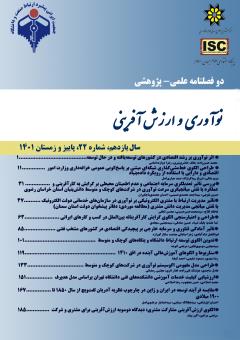سناریوها و الگوهای آموزش عالی آینده در افق 1410
محورهای موضوعی : عمومى
رضا مهدی
1
![]() ,
مسعود شفیعی
2
,
مسعود شفیعی
2
![]() ,
احمد کیخا
3
,
احمد کیخا
3
1 - دانشیار گروه مطالعات آیندهنگر، مؤسسه مطالعات فرهنگی و اجتماعی،تهران، ایران
2 - استاد، دانشکده مهندسی برق دانشگاه صنعتی امیرکبیر، تهران، ایران
3 - دانشجوی دکتری آموزش عالی، دانشکدة روانشناسی و علومتربیتی، دانشگاه تهران، تهران، ایران
کلید واژه: دورنمای آموزش عالی, آیندهپژوهی آموزش عالی, الگوهای آموزش عالی آینده, سناریوهای آموزش عالی,
چکیده مقاله :
آیندهپژوهی و توسعه سناریوهای پیشرو و فراهم کردن الزامات و راهکارهای مواجهه با آینده، یکی از مسئولیتهای مهم سیاستگذاران، رهبران و برنامهریزان آموزش عالی است. انواع عوامل و پیشرانها بهویژه فناوریهای اطلاعاتی و ارتباطاتی و تحولات دیجیتال، نقش دانشگاهها را برای شکلدهی نظام آموزش عالی گستردهتر، متحول کرده است. در این مقاله برمبنای مطالعه اور و همکاران (2020) پنج سناریو و الگوی آموزش عالی برای سال 1410 ارائه شده است. این سناریوها شامل تاماگوچی، جنگا، لگو، ترانسفورمر و کاربیجکن است. الگوی تاماگوچی، رویکرد کلاسیک به آموزش عالی است که بلافاصله پس از دبیرستان شروع، به مدرک کارشناسی یا کارشناسی ارشد منتهی و به شغل تبدیل میشود و مسیر آموزش عالی به پایان میرسد. الگوی جنگا، برای دانشجویان غیرسنتی دورههای یادگیری کوتاهمدت جذابتر است و بر مراحل بعدی خودآموزی و سازماندهی تمرکز دارد. الگوی لگو بهصورت پودمانهای ترکیبی مجزا با اندازههای مختلف نامگذاری شده است که بهجای یک واحد فشرده، یک مسیر یادگیری متکی به خود و غیراستاندارد ایجاد میکند. الگوی ترانسفورمر، یادگیرندگانی را نشان میدهد که ممکن است مدتها از آموزش پایه و اولیه آنها گذشته باشد، اما مجدداً برای کسب دانش جدید یا ارتقای مهارتهای مورد نیاز به آموزش عالی باز گردند. براساس این الگو، همه باید فرصتهایی برای ترک مسیرهای حرفهای فعلی و تغییر آن داشته باشند. در سناریوی کاربیجکن، فراگیران متناسب با شرایط و موقعیت کاری- زیستی و اهداف فردی و دانشگاهها و مؤسسات آموزشی بسته به رسالت نهادی و ارزشهای کانونی، ترکیبی از سناریوهای تاماگوچی، جنگا، لگو و ترانسفورمر را انتخاب میکنند. در این سناریو، انتخابهای یاددهی- یادگیری متعددی برای متقاضیان و نهادهای آموزشی فراهم خواهد شد. تحولات دیجیتال، نوآوری فنی و نوآوری اجتماعی است که پیامدهای آن برای جامعه، بازار کار و نظام آموزش عالی باید مد نظر باشد
Researching the future, developing future scenarios, and providing requirements and solutions to face the future are essential responsibilities of policymakers, leaders, and planners of higher education. Various factors and drivers, especially information and communication technologies and digital developments, have transformed universities' role in shaping the more comprehensive higher education system. In this article, based on the study of Orr et al. (2020), five scenarios and models of higher education for 2010 are presented. These scenarios include Tamagotchi, Jenga, Lego, Transformer, and Garbage Can. The Tamagotchi model is a classic approach to higher education that begins immediately after high school, leads to a bachelor's or master's degree, leads to a job, and ends the path to higher education. The Jenga model is more attractive to non-traditional students in short-term learning courses and focuses on the following stages of self-learning and organization. The Lego model is named separate composite modules of different sizes that create a self-contained, non-standardized learning path rather than a compact unit. The Transformer model represents learners who may be extended past their primary education but return to higher education to gain new knowledge or upgrade needed skills. According to this model, everyone should have opportunities to leave their current career path and change it. In the Garbage Can scenario, learners choose a combination of Tamagotchi, Jenga, Lego, and Transformer scenarios according to their work-life situation and individual goals. Universities and educational institutions depend on the institutional mission and focal values. In this scenario, applicants and academic institutions will have multiple teaching-learning choices. Digital developments are technical innovation and social innovation, the consequences of which should be considered for society, the labor market, and the higher education systemThe Tamagotchi model is a classic approach to higher education that begins immediately after high school, leads to a bachelor's or master's degree, leads to a job, and ends the path to higher education. The Jenga model is more attractive to non-traditional students in short-term learning courses and focuses on the next stages of self-learning and organization. The LEGO model is named as separate composite modules of different sizes that create a self-contained, non-standardized learning path rather than a compact unit. The transformer model represents learners who may be long past their basic education, but return to higher education to gain new knowledge or upgrade needed skills. According to this model, everyone should have opportunities to leave their current career path and change it. In the Karbeijken scenario, learners choose a combination of Tamagotchi, Jenga, Lego, and Transformer scenarios according to their work-life situation and individual goals, and universities and educational institutions depending on the institutional mission and focal values..
